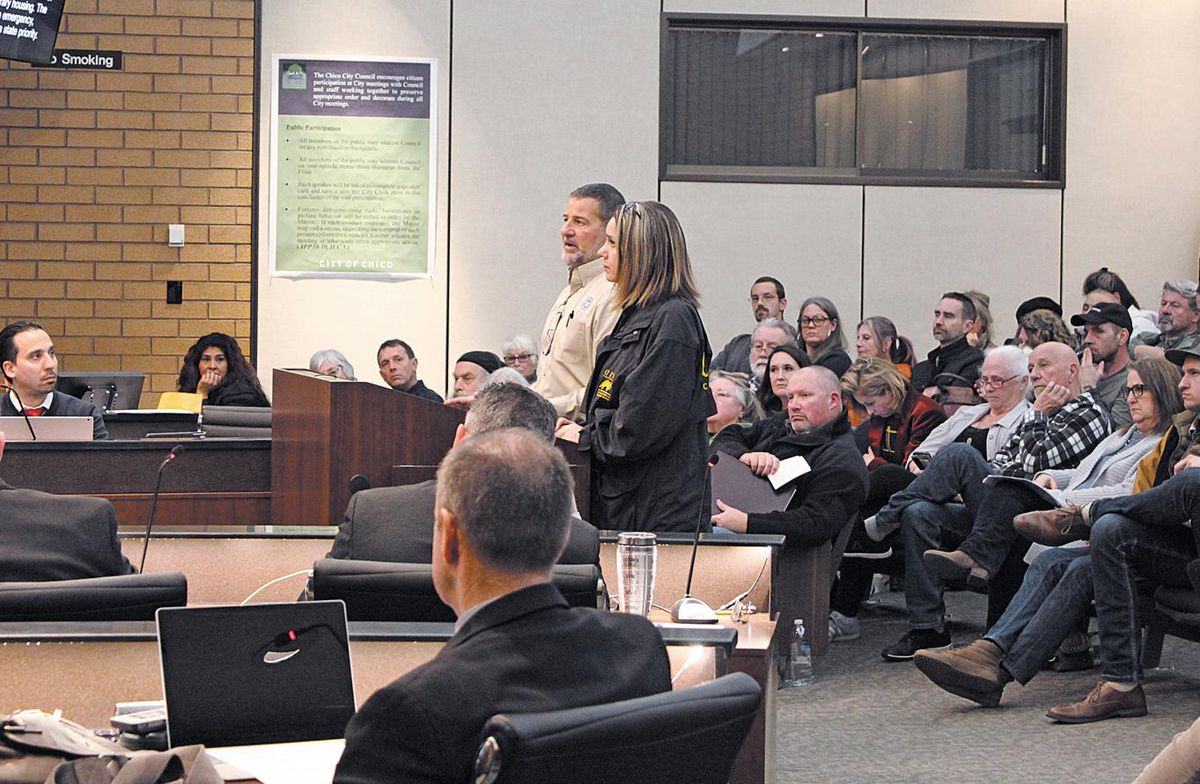
Photo by Ashiah Scharaga
Dan Horvath, of FEMA, and Katrina Palomar, of CalOES, tell the council they have faced barriers with developers and environmental constraints while attempting to set up temporary homes for Camp Fire survivors in Chico.
It was acknowledged across the City Council dais as a seemingly impossible directive for Chico City Manager Mark Orme: Open a temporary winter shelter in less than 24 hours.
Orme pleaded for more direction Tuesday (Feb. 5), but the panel had only suggestions on potential locations: vacated fire stations, perhaps? Tent-enclosed parking lots? The airport? City Hall? Each has its own roadblocks, and none are designed for human habitation.
But the mandate was as stark as the snow that fell on Chico earlier that day: This has to happen now, before more people die in the cold of winter. It is intended as a temporary measure, only for below-freezing nights.
“I’m tired of looking for everybody else to take action on this,” Mayor Randall Stone said. “People are coming here expecting us to provide safety for them. It’s literally freezing cold outside. People die in this weather, and we’re going to wait for the county to take action?”
The agenda item followed discussion about the Federal Emergency Management Agency’s plans to establish temporary housing for Camp Fire survivors—a thus-far unsuccessful effort in city limits—and yet another controversial topic, cannabis. The meeting concluded after 1 a.m.
Regarding a cold-weather emergency facility, the panel mostly spoke of the urgency to act, given recent freezing temperatures, and a vote in favor of the directive ultimately fell along party lines. Councilman Sean Morgan said the responsibility rests with the county and community nonprofits, not the city, which runs the risk of forever being in charge of emergency sheltering if it starts doing so now, despite it not being “in our wheelhouse.”
Butte County is tasked with opening emergency cooling and warming centers during extreme weather, with its main consideration being a prediction of three consecutive days of extreme temperatures.
Councilwoman Ann Schwab said she initially had the same concerns, considering the city had stepped in to fund the library, a county service, for a long time. However, this is a humanitarian crisis, she continued, and the council needs to act in the short-term as Orme works with nonprofits and other community organizations to formulate a long-term plan.
Most of the speakers, 11 total, were in favor of the emergency measure.
Among the naysayers was Jamie Jin, who said she was in support of shelters, but did not want evacuees and families from Paradise being taken in at the same location as criminals or those who are addicted to drugs.
Jin provided the council with a petition purportedly with about 2,000 signatures of citizens who do not want a low-barrier shelter downtown or in neighborhoods or near churches. This petition was created in response to Safe Space Winter Shelter’s collaboration with the Jesus Center and Torres Community Shelter to establish a permanent, year-round low-barrier shelter, funded by a $1 million Walmart grant.
For Dee Dee La Perle, herself a Camp Fire survivor, there was no pushback against mixing such populations. La Perle told the council she slept on the street last night, and the most pressing issue is getting everyone out of the elements.
“You all are warm and people are freezing, and if they die, the blood is all on your hands,” she chided. “Get real and do something. I’m tired of empty promises.”
Perhaps the most significant barrier: the operation. Safe Space board President Angela McLaughlin told the panel the nonprofit is struggling to find volunteers for its own low-barrier shelter, which is full, and probably wouldn’t be able to help.
Wednesday morning, Stone told the CN&R Orme is “working on two paths” and that, though the council authorized Orme to come up with a plan up to $100,000, the city is intending to secure private financing.
Putting the emergency shelter discussion into context, there still are no FEMA housing units in Chico three months after the Camp Fire.
There is some movement on that front, however, and in all likelihood, 48 furnished, temporary homes (modular or mobile) will be situated on 13 acres in the Hegan Lane Business Park. FEMA Northern Branch Director Dan Horvath told the council the project likely would move forward, with people getting settled within the next four months.
While 48 homes are better than none, some speakers addressing the dais noted, it’s a far cry from what is needed. FEMA has a projected need of 1,800 total units.
“It’s a very tedious process. We’re in negotiations with the land owners, the developers. We go through an environmental review process,” Horvath said. “We spend weeks at a lot of these sites, going through negotiations, only to find out in the end we aren’t able to come to an agreement.”
Those against the location mainly mentioned the traffic impacts. For Nathaniel Perry, who works near the proposed development, at Build.com, that was a flimsy excuse. “If we’re going to get started, this seems like a good place,” he said. “I’ll deal with the traffic.”
Also on Tuesday, the council directed the Internal Affairs Committee—Chair Alex Brown and Councilmen Karl Ory and Scott Huber—to brainstorm the stakeholder groups for a marijuana advisory committee, with the stipulation—requested by Morgan—that at least one representative be from law enforcement.
The committee will work with city staff and be tasked with determining the path for cannabis business in Chico, which overwhelmingly voted for state legalization in 2016. Those recommendations eventually will come to the council.
Vice Mayor Brown said that the voter support “speaks loudly to me,” and is why she brought the issue forward. The city can choose to regulate more than the state if it desires, but she’d like to see all of the options brought to the table, and that “we’re creating opportunities for businesses to be successful.”
